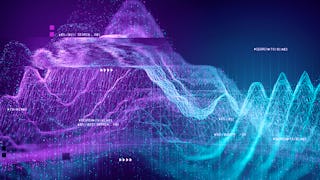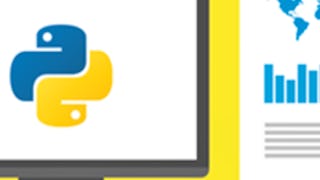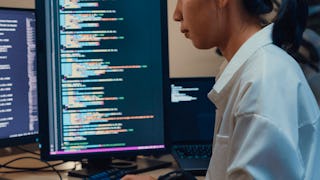Put the keystone in your Python Data Science skills by becoming proficient with Data Visualization and Modeling. This course is suited for intermediate programmers, who have some experience with NumPy and Pandas, that want to expand their skills for any career in data science. Whether you come to data science through social sciences and Statistics, or from a programming background, this course will integrate the two perspectives and offer unique insights from each.
Unlock access to 10,000+ courses with Coursera Plus. Start 7-Day free trial.


Data Visualization and Modeling in Python
包含在 中
您将学到什么
Create professional visualizations for many kinds of data Utilize Classification algorithms to make predictions using a dataset
您将获得的技能
- Data Science
- Pandas (Python Package)
- Statistical Inference
- Data Visualization Software
- Python Programming
- Matplotlib
- Data Visualization
- Predictive Analytics
- Statistics
- Data Cleansing
- Regression Analysis
- Data Manipulation
- Machine Learning Algorithms
- Predictive Modeling
- Scientific Visualization
- Probability & Statistics
- Data Analysis
要了解的详细信息

添加到您的领英档案
4 项作业
了解顶级公司的员工如何掌握热门技能

积累特定领域的专业知识
- 向行业专家学习新概念
- 获得对主题或工具的基础理解
- 通过实践项目培养工作相关技能
- 获得可共享的职业证书

该课程共有4个模块
In this module, you will learn about plotting in Python—an important technique for exploring a dataset, and an indispensable tool for communicating insights. We’ll learn to make all the most common types of plots used in data science including the basics like line, bar, and scatter plots, as well as more advanced plot types including histograms and heatmaps. We’ll learn both how to make these plots and how they can be customized for your needs using a core plotting library for python, matplotlib, which serves as the backbone for many python plotting tools. You’ll learn how to create professional, accessible, and information-rich plots, which you will leverage to quickly identify trends in data that would be difficult to otherwise recognize. We've also included some optional additional readings if you want to further enhance your learning!
涵盖的内容
1个视频30篇阅读材料1个作业5个非评分实验室
This module, you will learn the basics of how to use code to make predictions based on data. After discussing what prediction is, you’ll learn to describe the concepts that underlie predictive algorithms within the context of the K-Nearest Neighbors (KNN) algorithm for both classification and regression. Additionally, you’ll learn to evaluate the accuracy of a predictive algorithm to assess its ability to generalize to new data. You will build your own KNN classification and regression algorithms from scratch and make predictions with each of them. At the end of this module, we’ll have a quiz to give you the opportunity to evaluate your understanding of predictive algorithms and reflect on your experience implementing your own.
涵盖的内容
1个视频7篇阅读材料1个作业5个非评分实验室
This module, you will learn how to describe the differences between prediction and inference, two key Data Science concepts. You’ll learn how to implement linear regressions — one of the most useful tools that data scientists have for inference and prediction — and other statistical models in Python. You’ll apply this knowledge by examining a dataset and regressing multiple variables on each other, and describing the insights on their relationships.
涵盖的内容
1个视频7篇阅读材料1个作业2个非评分实验室
This module, you’ll bring together the concepts and skills you’ve developed throughout the course to create a final project for your data science portfolio. You’ll recreate a now-famous data visualization that illustrates the relationship between the income of countries and their greenhouse gas emissions on a global scale. To do this, you’ll explore and prepare 4 datasets and merge them into a composite dataset that you’ll plot. Creating this merged dataset is an important step, and you’ll validate your merged dataset with a short quiz on the insights within. The end result of this effort will be a publication-quality plot that makes a compelling point about the relationship between emissions and income—an impactful visualization that showcases your growing programming skills for data science applications.
涵盖的内容
6篇阅读材料1个作业7个非评分实验室
获得职业证书
将此证书添加到您的 LinkedIn 个人资料、简历或履历中。在社交媒体和绩效考核中分享。
从 Data Analysis 浏览更多内容
 状态:免费试用
状态:免费试用Duke University
 状态:免费试用
状态:免费试用 状态:免费试用
状态:免费试用 状态:免费试用
状态:免费试用
人们为什么选择 Coursera 来帮助自己实现职业发展




常见问题
To access the course materials, assignments and to earn a Certificate, you will need to purchase the Certificate experience when you enroll in a course. You can try a Free Trial instead, or apply for Financial Aid. The course may offer 'Full Course, No Certificate' instead. This option lets you see all course materials, submit required assessments, and get a final grade. This also means that you will not be able to purchase a Certificate experience.
When you enroll in the course, you get access to all of the courses in the Specialization, and you earn a certificate when you complete the work. Your electronic Certificate will be added to your Accomplishments page - from there, you can print your Certificate or add it to your LinkedIn profile.
Yes. In select learning programs, you can apply for financial aid or a scholarship if you can’t afford the enrollment fee. If fin aid or scholarship is available for your learning program selection, you’ll find a link to apply on the description page.
更多问题
提供助学金,







